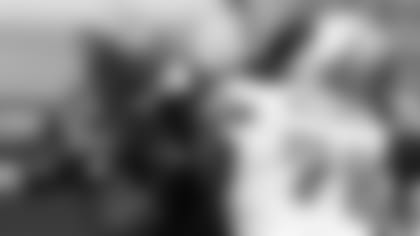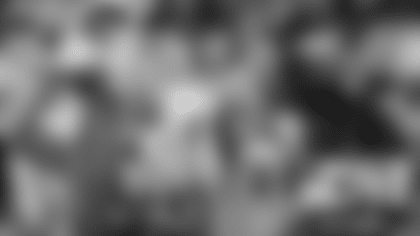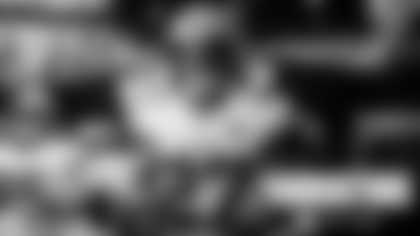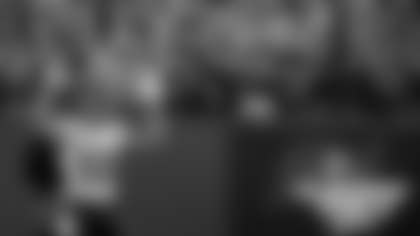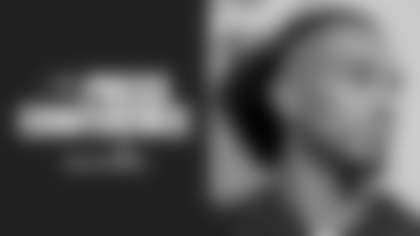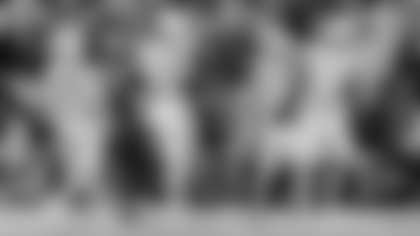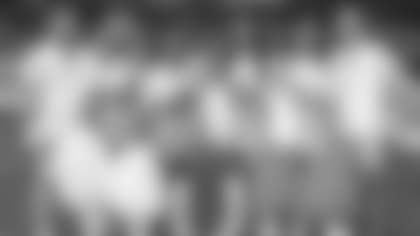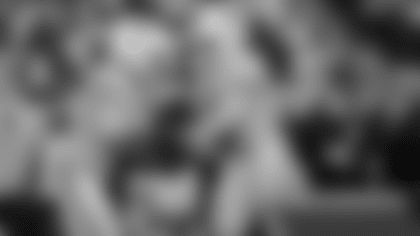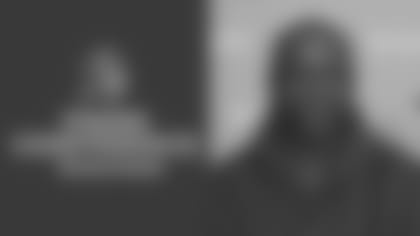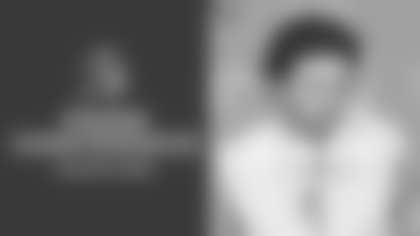On a normal NFL calendar, training camp would be right around the corner…and hopefully that will be the case in 2011, as well, even though this year has been anything but normal.
More than ever given this strange offseason, training camp will be a period for teams to sort out the roster, identify strengths and weaknesses and address any obvious shortcomings. Obviously, each team in the league has had plenty of time this offseason to evaluate how the depth chart stands heading into training camp…and that's exactly what Buccaneers.com is doing in this series of articles entitled "Camp Check."
Between now and the start of training camp, we will be taking a position-by-position look at the team's roster in regard to where it stands now and how it might change before or during camp. We will compare the current depth chart to how it appeared heading into last year's camp and take a look at the position's overall performance during the 2010 season. We'll also examine the potential of free agency impact, including the players that could potentially be available, and how commonly the Buccaneers have addressed the position on the open market in the past.
The fifth position to get a Camp Check is defensive end, which will certainly have a new look in 2011. Unlike our most recent Check on the offensive line, we're going to split the defensive front into ends and tackles, as there is a pretty distinct storyline for each group.
[Note: Analysis in the "Camp Check" series is not meant to reflect the opinions, intentions or strategies of the Buccaneers' actual player personnel decision-makers.]
**
Defensive Ends Currently on the Buccaneers' Roster:
Tampa Bay's current roster actually has a very large group of defensive ends, which is obviously due in part to the 2011 draft, in which the Bucs used their first and second-round picks on Adrian Clayborn and Da'Quan Bowers. In addition, the team acquired a handful of young ends along the way during the 2010 season, some on the active roster and some on the practice squad.
In all, there are 11 defensive ends on a roster that has been frozen in place since March. That does include several pending free agents (see below), and it is largely populated by players with whom Buccaneer fans are not yet familiar, namely Brandon Gilbeaux, George Johnson, Alex Magee, E.J. Wilson and Doug Worthington.
That large group includes three players the team has drafted in recent years – Clayborn, Bowers and 2009 fourth-rounder Kyle Moore – plus two more it signed during the course of the 2009 campaign who have proven valuable – Tim Crowder and Michael Bennett. A few of those players, most notably Moore and Bennett, have at times been used as swingmen as they are versatile enough to play inside as well, but for the purposes of this Camp Check and the upcoming one on defensive tackles, we are treating them exclusively as ends. Of course, that sort of versatility often helps a young player like Moore or Bennett make the regular-season roster, so it's a factor we should still keep in mind.
Crowder and White were the primary starters last year, though Moore held the left end job when the season began before eventually succumbing to injury. At the end of the season, Bennett replaced White as the starter for the last two games.
**
Defensive Ends Taken to Training Camp by Tampa Bay in 2010:
The Buccaneers have more ends on the roster right now (including eventual free agents) than the number that they took to training camp last year. Tampa Bay opened camp with eight ends, three of whom were undrafted free agents (Gilbeaux, Johnson and James Ruffin). There was a fourth rookie in the mix in 2010 seventh-round draft pick Erik Lorig, but Lorig would eventually be switched to offense and take up the fullback position.
Johnson was released before the Bucs played their first preseason game, but he returned two weeks later and in early September was added to the first iteration of its practice squad. He would eventually get a promotion to the 53-man roster in time for the final three weeks of the season, though he did not appear in a game. Gilbeaux, a promising-looking prospect out of Delaware, was hurt during the preseason and was placed on injured reserve on August 24, the same day Johnson returned.
Moore and White were the starters entering and leaving training camp, though a little early-game shuffling in the first two contests of the regular season actually led to rookie DT Gerald McCoy starting at right end. In the second of those two games, Moore slid inside to defensive tackle on the opening snap.
When the smoke had cleared from the preseason and training camp, the Bucs had kept only five of those eight ends and one, Lorig, would be moved to the practice squad a week later, then re-signed and converted to offense. Crowder and Bennett would serve as the reserves behind Moore and White, though both would end up playing extensively. Crowder, in particular, saw a lot of action, eventually taking over for Moore as the starting left end at midseason.
**
Impact of the 2011 NFL Draft on the Bucs' Defensive Ends:
As mentioned, huge.
For the second straight year, the Buccaneers' greatest area of need on the depth chart matched up beautifully with the strength of the draft field. As most analysts correctly predicted, the Bucs targeted defensive end in the first round, specifically going after the hard-working Clayborn. A relentless player with great quickness of the edge and a well-developed array of moves, Clayborn is the best bet to start at right end this season.
The drafting of Bowers was more about taking advantage of an unexpected opportunity. At one point mentioned as a possible first overall pick in 2011, Bowers slid well into the second round due to concerns about his injured knee. The Buccaneers did extensive homework and felt the gamble was well worth it at #59 overall. Assuming he has progressed rapidly enough in his rehabilitation from winter surgery, Bowers could easily join his fellow 2011 draftee in the starting lineup. He is considered a natural left end, so the two rookies could make an impressive pair of bookends in Tampa for years to come.
Obviously, starting the draft with both Clayborn and Bowers will affect everything else the Buccaneers do at the end position. The team isn't likely to invest much more in the position, and even the upcoming crop of undrafted free agents would seem like less of a target for the Bucs than usual given that they still have Gilbeaux, Johnson, Wilson and Worthington on hand behind their new rookie teammates. And the state of Bowers' knee on opening day will probably affect how many ends the team keeps overall.
**
Buccaneers' Defensive End Performance in 2010:
In terms of the money stat for defensive ends, it wasn't a particularly good season for that group, or for the Buccaneers' defense as a whole. Tampa Bay ranked 30th in the NFL in sacks recorded per pass play, finishing the year with a total of 26 QB takedowns. It was particularly rough during the first half of the season, when the Bucs posted only six sacks through eight games, four of them occurring on one afternoon. In five of those first eight games, the Bucs' defense was held without a sack.
The actual pressure on the quarterback was actually a little better than that, especially during the second half, as evidenced by the team's rank of seventh on the NFL's interceptions-per-pass-play chart. Pressure in the backfield definitely helped the Buccaneers a very fine 9 turnover ratio, which tied for fifth-best in the league. The front line also held its own against the run, particularly when Crowder was on the field. Tampa Bay ranked 28th against the run, which is obviously not a particularly positive number, but again the team was better in the second half of the season. All four of the games in which the Bucs held opponents below 100 rushing yards occurred during the last seven weeks of the season.
Individually, ends produced two of the three highest sack totals on the team, but not with totals that speak of a healthy pass rush. White was first with 4.5, followed by linebacker Geno Hayes with 4.0 and then Crowder with 3.0. The team had high hopes for Moore but he was unable to overcome a nagging shoulder injury and was shut down at midseason. A midseason trade for Magee was a low-risk maneuver that paid off to some extent; Magee contributed two sacks and looked like a player the team could develop further in training camp this year.
**
Potential Impact of Veteran Free Agency on Tampa Bay's Defensive Ends:
As mentioned above, Crowder and White had the top totals among Buccaneer defensive ends last year in both games played and sacks. Those two are also the oldest and most experienced players in that mostly youthful group, though at 26 Crowder is hardly over the hill. Because he spent several years trying to establish himself in NFL training camps, and then several more years in the Arena league before he joined the Buccaneers in 2007, White is about to turn 32 despite having a relatively brief career to this point.
Crowder and White are both likely to become free agents once the labor situation is resolved, assuming that the required number of years to hit the unrestricted market is rolled back to four. Again, it's hard to imagine the Buccaneers paying too steeply for any player at that position, given that they envision the Clayborn-Bowers pair as their starting duo for years to come. Still, Crowder might still have some upside at his age and he has definitely been a valuable player since the Buccaneers plucked him off waivers from Denver early in 2009.
There isn't expected to be a huge market of free agent defensive ends once the league year begins, so it may be a moot point for the Buccaneers. On the other hand, there should be ends in number, as will be the case at virtually every position. The restrictive rules of last year's free agency coupled with the likely rollback to the four-year-eligibility level is expected to create the largest market ever – and teams will have only a short time to take advantage of it.
Therefore, there may be some interestingly affordable players on the market. Tennessee's Jason Babin, coming off a career-best 12.5-sack season, will certainly look attractive to some suitors, and others may be interested in former Colts reserve Raheem Brock after his nine-sack campaign for Seattle last year.
Two players who were injured for much of last season will get some attention – Marcus Spears of the Dallas Cowboys and Mathias Kiwanuka of the New York Giants. Minnesota's Ray Edwards and Green Bay's Cullen Jenkins may end up with the biggest deals, but Charles Johnson, who had a breakout season with Carolina last year, might fly a little more under the radar.
**
Buccaneers' Free Agency History at Defensive End:
The franchise certainly has one enormous free agent hit at the position: Simeon Rice.
The third overall pick in the 1996 draft, Rice signed with the Buccaneers in 2001 after a tumultuous five seasons in Arizona that included three double-digit sack campaigns as well as several disagreements with team management. Tampa Bay Defensive Coordinator Monte Kiffin badly wanted to add Rice to his front line, which already included a sack machine on the interior in Warren Sapp. Kiffin believed Rice's presence would make Sapp more dangerous, and vice versa, and he was dead on.
Rice racked up 69.5 sacks in just six seasons with the Buccaneers, hitting double digits in each of the first five and peaking at 15.5 in the team's 2002 Super Bowl campaign. Rice was quite simply one of the three or four best pass-rushers in the entire NFL during the first half of the decade.
A year later, the Buccaneers hit the jackpot again, this time on a lower-profile free agent who proved to be much better than expected. That would be Greg Spires, who had started a total of eight games in four seasons in New England and Cleveland. Spires unexpectedly beat out Marcus Jones for the starting left end spot to begin 2002 and by the end of the year he was another key figure on the Bucs' dominant defensive line. Spires played six very good seasons in Tampa, starting the entire time, and while he wasn't quite the sack artist that Rice was – who is? – he was an outstanding all around player who could rush the passer and stop the run.
The Bucs really haven't dipped into the free agent pool at defensive end very often otherwise. There have been a few low-risk efforts along the way, such as Lamar King, but no one else who came in with very high expectations.
**
Final Defensive End Analysis:
The Buccaneers are brimming with optimism that an area of weakness in recent years will quickly turn into a strength in 2011, and for years to come. That's what happens when you devote your first and second-round picks to the position, and when you bring in two players who have the potential to be elite-level pass-rushers.
Clayborn and Bowers could do what Josh Freeman has done for the Buccaneers' quarterback position, and perhaps just as quickly. The Bucs have not had a dominant player at the position since Rice, and they haven't had one of the league's better pass rush crews since the Super Bowl era. There is no guarantee that the two incoming rookies will solve that issue, but the Buccaneers certainly couldn't have done much more to address the issue. Watching how those two develop, along with a host of other young players at the position, should be one of the most interesting Buccaneer storylines of the year.


